
 Important note about plant availability. Important note about plant availability.There are hundreds of factsheets on our website provided for your information. Not all plants will be available at all times throughout the year. To confirm availability please call (03) 8850 3030 and ask for the nursery. |
Citrus australasica
Finger limes (Citrus australasica & Citrus australasica var. sanguinea) are native to the rainforests of SE Queensland and northern NSW. A naturally thorny 6m tall understory tree producing the highly desirable 6-12cm long finger shaped fruit; they are highly adaptable and commercially are grown in poor soils. Finger limes are genetically very diverse and it is this diversity that has resulted in the wide range of named cultivars displaying many and varied colours. Grafted trees (root stock is Citrus trifoliata) will give you true to name fruit and will begin fruiting in year three, and will be fully productive at year six – producing up to 20kg fruit.
Position
Find a spot that has some protection from hot afternoon sun which can burn the fruit
Fruiting
The development period from flowering to harvest is around 5 months. Make sure trees have sufficient water at flowering and fruit set, and over the fruit growth time. As with most citrus, fruit drop can occur naturally early in the season if more fruit is set then the tree can carry. Fruit may also be shed during very hot dry and or windy conditions.
Fertilising
Finger limes require a lot less fertiliser than other citrus, possibly due to smaller leaves and reduced canopy. Commercial growers apply only 25-30% of the normal amount of fertiliser. The majority of feeder roots tend to be in the top 30-60cm of soil and a low phosphorus fertiliser is recommended, applied in small amounts 2-3 times in the growing season. Over fertilising can cause dieback. Do NOT apply fertiliser from flowering up until the fruit is a minimum of 1cm long or fruit can abort.

Pruning
Avoid pruning in hot weather as the exposure to the sun may burn the fruit. The trees like regular light pruning – heavy pruning can kill a fingerlime. Cut back any vigorous water shoots and suckers from rootstocks, and try to establish an open tree with 4-6 main branches. Once mature, an annual prune after harvest to renew fruiting wood and to keep trees to a manageable size (hard to get the fruit when they are 5m off the ground…). Removing crossing branches and excessive growth helps protect the fruit from damage by nearby thorny branches.
 Important note about plant availability. Important note about plant availability.There are hundreds of factsheets on our website provided for your information. Not all plants will be available at all times throughout the year. To confirm availability please call (03) 8850 3030 and ask for the nursery. |
Cultivars
More new ones come onto the market every year, as well as new hybrids, crossed with mandarins and cumquats. Generally bred for colour and degree of seediness, new cultivars range from pale green to dark red.
New Cultivars
‘Australian Blood’ (syn ‘Australian Red Centre’) is a hybrid with blood red rind, flesh and juice. This hybrid was produced by CSIRO by open pollination, from a cross between an Ellendale Mandarin (a mandarin and orange hybrid) and a seedling form of the Australian Finger lime (Citrus australasica var. sanguinea).
‘Australian Sunrise’ another hybrid producing pear shaped orange fruit which makes a stunning marmalade. This is a complex hybrid also developed by CSIRO: Citrus australasica x (Fortunella sp. x Citrus reticulata).
‘Australian outback’ (syn ‘Australian Desert’) (Citrus galuca) Not a finger lime but a native lime producing small round green juicy fruits ripening late December. Wonderful in fruit sauces and as a garnish. Trees are tough, withstanding both extreme heat and frosts. Interesting fact: Trees are thorny to protect themselves from grazing by native animals, but above kangaroo grazing height they do not produce thorns. Commercial propagators take the non thorny material and graft onto commercial root stock (commonly the trifoliate rootstock).
‘Pink Ice’: Slightly bitter – think of grapefruit – wonderful as a garnish in drinks or seafood
‘Pink Champagne’: Plump fruit, crisp clean flavour. Grapefruit.
‘Rainforest Pearl’: A peppery number with bite. Piquant. Tash’s favourite
‘Red Champagne’:Red skin and flesh, amazing bouquet of flavours: Spiced apple, berry, apricot
‘Alstonville’: One of the easiest fingerlimes – fewer seeds and smooth easy eating flavours.
‘Chartreuse’: Gently acidic and lime flavoured, excellent lime/lemon replacer for seafood, garnishes, in your G&T.
‘Crystal’: Green skin, green ‘caviar’ – very fresh, very juicy
‘Crimson Tide’: Amazing deep red caviar, almost black skin
‘Yellow’: Grafted variety. Yellow skin and yellow flesh with lemong tang and grapefruit tones. Very pretty. Paul’s personal favourite.
And loads more coming onto the market all the time…
Uses in the kitchen
The juice of this lime is similar to exotic limes, but the juice is held in compressed juice vesicles which look a little like caviar. When the thin skin of the lime is cut, these vesicles can be removed and added to drinks, canapés (oysters for example), desserts, fruit salads, and used as a garnish or decoration. The vesicles will bounce up and down if added to carbonated drinks, which is sure to be a conversation starter at your next party. Juiced, the Australian finger lime can be used as a Tahitian lime substitute. For example, in south-east Asian cuisine. Finger limes can also be pickled or made into marmalade.
Recipe
SUMMER CURED ATLANTIC SALMON WITH AUSTRALIAN NATIVE FINGERLIMES.
Ingredients :
400 g Atlantic Salmon (skinned and boned)
2 Lemons, juiced
4 Australian Native Finger limes
40 ml Mirin
25 ml Rice Wine Vinegar
1 stick of Lemongrass (bashed with a mallet)
Pinch of Sea Salt
Pinch of White Pepper
½ bunch of Coriander
4 Bamboo skewers (soaked in water first)
Bunch of Rocket
Splash of Soy Sauce
Method :
Cut the salmon into finger-size lengths . Skewer the salmon length ways so you end up with long salmon kebabs .
Mix lemon and Australian Native Finger limes juice and pulp, mirin, rice wine vinegar , sea salt , pepper and lemongrass in a bowl .
Place salmon skewers in a shallow dish and pour liquid over the kebabs . Refrigerate for 5 minutes .
Serve on a bed of rocket with a little soy sauce drizzled over the top , and finish with picked coriander (This method of cookery is French and requires the acid in the citrus to slowly cook the fish) .





